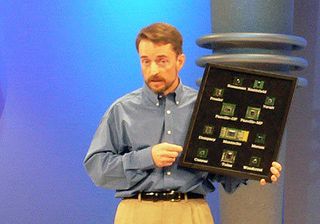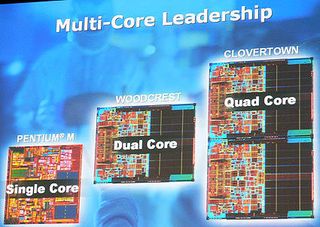IDF Spring 2006: Will Intel's Core Architecture Close the Technology Gap?
Quad Cores In Multi-Chip Packages By 2007

The trend for future multi-core processors is simple: There will be even bigger caches and possibly smaller cores, because this is the only way Intel could possibly make its vision of packing hundreds of cores on a single die come true within the next decade. The next generation of processors, however, will be available in the second half of 2007: Kentsfield in the desktop and Clowertown in the server/workstation space will merge two dual-core Conroe or Woodcrest dies into one package.
This will be described as a multi-chip package and is already being used today with the Pentium D Presler, which is based on two Cedar Mill type Pentium 4 chips. Of course, there are disadvantages, such as L2 cache access: Separated caches create an additional FSB load as soon as one processor needs to access the other's L2 memory. But from a business point of view, this approach definitely makes sense: It will still scale up performance quite a bit, while the implementation is something that can be done based on a 65-nm silicon process. Intel stated that we should not expect monolithic quad-core processors prior to the introduction of 45-nm manufacturing.

The way to quad cores is paved: First there will be multi-chip packages, which will involve the integration of two, dual-core processors into one die.

This is the dual core armada for this year and H1/2007.
Stay on the Cutting Edge
Join the experts who read Tom's Hardware for the inside track on enthusiast PC tech news — and have for over 25 years. We'll send breaking news and in-depth reviews of CPUs, GPUs, AI, maker hardware and more straight to your inbox.
Current page: Quad Cores In Multi-Chip Packages By 2007
Prev Page Intel's Energy Awakening Next Page Core To The RescueMost Popular

